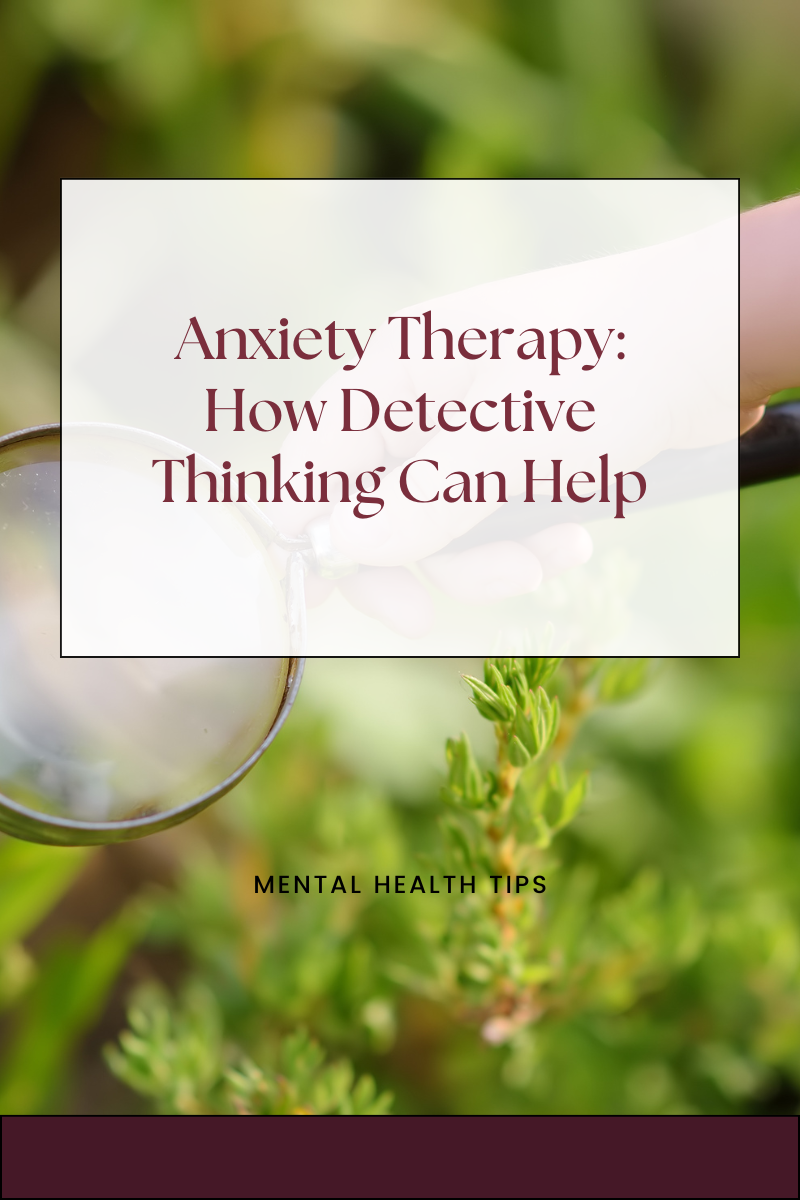Anxiety is clever. It sneaks in with stories that feel true—stories like “I’ll mess this up,” or “They probably think I’m incompetent.” For many of my clients seeking anxiety therapy in Scottsdale, these thoughts aren’t new. They’re well-worn mental loops, reinforced by perfectionism, past experiences, and the invisible pressure to hold it all together.
But here’s the secret: not every thought deserves to be believed.
That’s where Detective Thinking comes in.
What Is Detective Thinking?
Detective Thinking is a simple, structured way to evaluate anxious thoughts like a neutral observer, just like a detective would. You ask questions, gather facts, examine evidence, and challenge faulty conclusions. This cognitive strategy, often used in Cognitive Behavioral Therapy (CBT), is especially effective for high-achievers, professionals, and teens who struggle with self-doubt and overthinking. In this visual, you’ll be able to see that often it isn’t one thought weighing you down, it’s fears about fears and worries on worries.
Anxiety Therapy Strategies
When we feel anxious, our thoughts can spiral quickly. Detective Thinking slows the spiral down. It helps you:
- Spot the difference between facts and feelings
- Notice cognitive distortions like catastrophizing or mind-reading
- Challenge anxious beliefs with compassionate logic
- Practice more realistic and flexible thinking
For example, you might say “I’m worried for this job interview”. After looking through your detective lens, you might realize: I’m worried to be asked questions about statistics, I’m worried about where to park, I’m worried about whether to introduce myself with my full name or nickname. These are all thoughts that weigh us down until ultimately, our load is too heavy to carry. By labeling each of the heavy bricks in our backpack, we can then begin to remove them; either by realizing that the brick is outside of our power and control to change, or that it has an easy solution, or that it is not likely (which we might come to realize by evaluating the following questions.)
- What’s the actual evidence?
- What would I tell a friend who had this thought?
- What’s a more balanced alternative thought?
The goal isn’t to “think positive”—it’s to think like a detective and be clear on our thoughts.
Therapy Tools for Clients and Clinicians
I regularly use this approach in both anxiety therapy in Scottsdale and in my work offering clinical supervision in Arizona. Whether I’m working with a client facing constant self-criticism or mentoring a new clinician learning to guide thought-challenging exercises, Detective Thinking is one of the most accessible tools in our therapeutic toolbox.
It’s especially helpful for:
- Adults with perfectionism or imposter syndrome
- Teens struggling with academic anxiety
- Clients dealing with trauma-related overcontrol
- Supervisees learning to blend CBT with trauma-informed care
Download the Free Detective Thinking Worksheet
Want to try it for yourself or with your clients? I’ve created a printable, therapist-friendly version of the Detective Thinking Worksheet, perfect for both individual and group use.
Whether you’re a therapist looking to expand your interventions or a client wanting a way to untangle your anxious thoughts, this resource is a great place to start.
A Note for Therapists
If you’re a clinician pursuing your LCSW or LPC and looking for supportive, structured clinical supervision in Arizona, I offer individual and group supervision with a goal to encompass formative and restorative supervision. My goal is to help you feel competent, confident, and connected as you grow into your role.
Ready to Challenge Anxiety With Clarity?
Therapy doesn’t have to be complicated. Sometimes, all it takes is a worksheet, a pen, and a little curiosity to shift the way you think.
If you’re ready to explore anxiety therapy in Scottsdale or are seeking clinical supervision in Arizona, I’d love to support you.
📬 Contact me directly at LorainMoorehead.com
🎧 Or check out more therapy insights on The Self Careapist Podcast

+ show Comments
- Hide Comments
add a comment